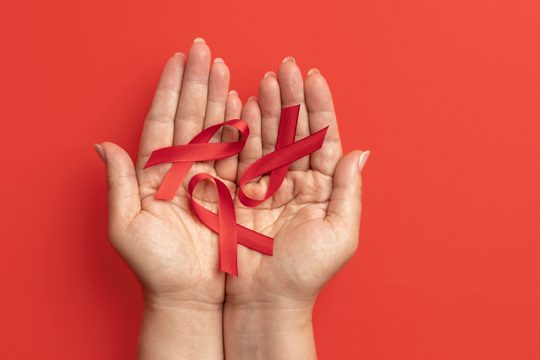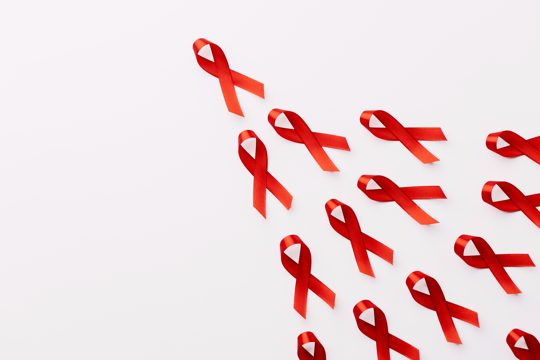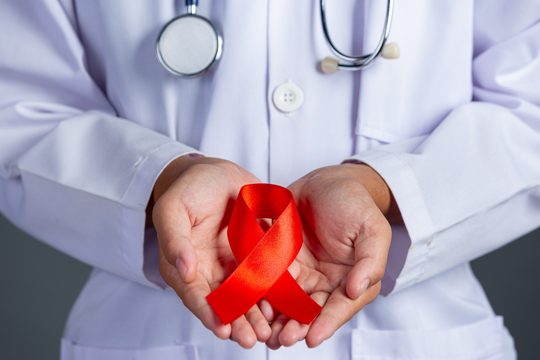What are the Early Signs of HIV?
HIV, short for Human Immunodeficiency Virus, is a virus that attacks the bodys immune system. If not treated, it can lead to AIDS (Acquired Immunodeficiency Syndrome).
Recognizing the early signs of HIV can help in managing the condition effectively. HIV, an acronym for Human Immunodeficiency Virus, is a potent virus that launches a relentless assault on the body's immune system. This microscopic enemy infiltrates the body, gradually weakening its fortifications against diseases and infections. Over time, if this invader is left unchecked and untreated, it can evolve into a far more severe condition known as AIDS, or Acquired Immunodeficiency Syndrome. It's crucial to underline the importance of early detection.

Recognizing the initial signs of HIV can significantly aid in effectively managing and controlling the condition. It's similar to being alerted to a storm on the horizon; the sooner you know it's coming, the more time you have to prepare and minimize the potential damage.
Awareness of these early warning signals can be the difference between being overwhelmed by the storm or weathering it. The battle against HIV is not an easy one, but it's far from impossible. With the right knowledge and timely medical intervention, you can effectively manage the condition, maintain your health, and continue to lead a fulfilling life. Remember, knowledge is power, and in this case, it could be the key to holding the line against the disease's progression.
The Early Signs of HIV Infection
The early signs of HIV infection tend to be nonspecific, meaning they can resemble symptoms of other common illnesses. These signs can appear within two to four weeks after the initial infection.
Indeed, the early indications of HIV infection are often quite nonspecific, subtly mirroring the symptoms of other ordinary, everyday illnesses. This deceptive similarity can easily lead to misinterpretations, often resulting in a delay of an accurate diagnosis. It's a tricky and somewhat confusing situation that calls for keen observation and immediate medical consultation should any lingering doubts persist. These initial signs of HIV infection usually start to make their presence known within a short period, typically within two to four weeks following the initial exposure and infection. It's a relatively quick progression that may give pause, especially when considering the gravity of the condition.

However, this swift manifestation also serves as a crucial warning—providing the infected individual with a critical window of opportunity to seek immediate medical attention and begin the process of managing the disease. The early detection and diagnosis of HIV are pivotal in the management and treatment of this life-altering condition.
The ambiguity of the initial symptoms may seem discouraging, but armed with the right knowledge and proactive healthcare approach, it's a challenge that can be effectively tackled. Remember, the early signs of HIV infection may be nonspecific, but they are not insignificant. Listen to your body, seek early medical advice, and remember that your health is your wealth.
15 Early Signs and Symptoms of HIV in Men
Symptoms can vary from person to person, but some common early signs of HIV in men include fever, skin rash, headaches, a sore throat, and tiredness. Other symptoms may include dementia, weight loss, fatigue, ulcers in the mouth, ulcers on the genitals, night sweating, nausea or vomiting, sore muscles, pain in the joints, and swollen lymph nodes.
While the manifestation of symptoms can dramatically fluctuate from one individual to another, there are some general early signs of HIV infection in men that are commonly observed. These initial symptoms often mirror those of a severe flu and include a high fever, an unexplained skin rash that could potentially cover the entire body, persistent headaches that tend to linger, a raw and sore throat that may make swallowing a challenge, and an overwhelming sense of tiredness that seems to pervade every waking moment. However, as the virus continues to attack the immune system, additional symptoms may emerge, some of which can be quite severe. Cognitive decline, often resembling dementia, can lead to confusion, memory loss, and difficulty concentrating. Unintentional weight loss, even without changes in diet or physical activity, can be a notable sign. Chronic fatigue, a persistent feeling of exhaustion that doesn't go away with rest, can make even daily tasks challenging. Ulcers may appear in the mouth, making eating and drinking painful, or on the genitals, leading to discomfort and potential complications in sexual activity.

Night sweating can disrupt sleep patterns, leading to further tiredness and a drop in overall health. Nausea or vomiting can lead to decreased appetite and further weight loss.
Muscle soreness and joint pain can limit mobility and decrease quality of life. Swollen lymph nodes, often one of the first signs of an immune system fighting off an infection, can be a telltale sign of HIV. These symptoms can be subtle at first, but become more severe as the virus progresses. It's important to note that these symptoms alone are not a definitive diagnosis of HIV. They can be indicative of other health issues and should be evaluated by a healthcare professional.
Less Common Symptoms
Less commonly, some people may experience mouth ulcers, nausea, and other symptoms. These symptoms may occur due to the bodys immune system fighting off the virus.
In a less frequent set of circumstances, certain individuals may encounter the uncomfortable and often bothersome occurrence of mouth ulcers. These small, yet painful sores can appear on the gums, tongue, or inside of the cheeks, adding a layer of discomfort to the individual's daily life. In addition to mouth ulcers, nausea can also play a pivotal role in the individual's overall wellbeing. The unsettling sensation of feeling queasy or on the brink of vomiting can be a distressing experience, potentially causing disruption to daily routines and activities. Moreover, these symptoms may be accompanied by other manifestations such as fatigue, headaches, and a diminished appetite. The individual might also experience a fluctuating temperature, exhibiting signs of fever, which can further exasperate the overall discomfort.

Such symptoms, although inconvenient and discomforting, are generally indicative of the body's immune system actively engaging in combat against the invading virus. This internal defense mechanism is a testament to the body's remarkable ability to fight off foreign pathogens.
It's crucial to understand that these symptoms, however unpleasant, are a sign that your body is working hard to keep you healthy. Therefore, while these symptoms can be distressing, they are an essential part of the recovery process. In conclusion, while the manifestation of symptoms such as mouth ulcers, nausea, and other associated discomforts could be distressing, they are indications of the body's robust immune response against the virus. Recognizing these signs and responding appropriately can significantly aid in the overall recovery and restoration of health.
How Common is HIV?
According to the Centers for Disease Control and Prevention, about 1. 2 million people in the United States are living with HIV, and approximately 14% of them (or 1 in 7) don’t know they are infected.
As per the statistics released by the reputable Centers for Disease Control and Prevention, it is estimated that an alarming figure of roughly 1. 2 million individuals in the United States are grappling with the life-altering diagnosis of HIV. This means that in every corner of the country, from bustling metropolises to quiet rural towns, people are facing this invisible enemy on a daily basis. A battle fought not in the public eye, but in the private sphere of their lives. Even more concerning is the fact that approximately 14% of these individuals, equating to roughly 1 in every 7, remain blissfully unaware of their infection status. This lack of awareness is not only detrimental to their health but also poses a considerable health risk to the populace at large, as these unknowing carriers may inadvertently contribute to the spread of the virus.

This statistic serves as a stark reminder of the importance of regular testing, not just for those who believe they may have been exposed, but for everyone, as this invisible enemy does not discriminate. This data from the CDC provides a sobering picture of the HIV landscape in the U.
S. , highlighting the significant work that still needs to be done in the areas of testing, treatment, and education. It underscores the importance of continually raising awareness about this disease and the necessity for regular testing. It also reiterates the need for ongoing research and development in finding more effective treatments and hopefully, one day, a cure. This isn't just a battle for those living with HIV, but one that we as a society must collectively fight.
Timeline of HIV
HIV progresses in stages if left untreated, starting with the acute phase, moving to clinical latency, and lastly to AIDS, the most severe phase. HIV, a life-altering virus, progresses in stages, each distinct and progressively more severe, if left without the necessary medical intervention.
The onset of this journey commences with the acute phase, an initial period where the virus rapidly multiplies and spreads throughout the body. This stage is often accompanied by flu-like symptoms, serving as the body's initial response to the virus. Some people may not even be aware of their infection during this phase as the symptoms can be quite mild and easily mistaken for a common cold or flu. The virus then stealthily transitions into the clinical latency stage, otherwise known as the chronic phase. In this stage, HIV continues to live, reproduce, and cause potential damage within the body, albeit at a slower pace. The virus is less active, but is by no means dormant. It's a deceptive period of relative calm, where the infected individual might not exhibit any outward symptoms, creating a false sense of security.

However, without treatment, the virus continues to wear down the immune system gradually. Eventually, the disease reaches its final, most severe phase - AIDS, or Acquired Immunodeficiency Syndrome.
In this stage, the body's immune system is severely weakened, leaving it vulnerable to a range of opportunistic infections and diseases. It becomes a battle of attrition, with the body's defenses no longer capable of warding off even the most common infections. The transition from HIV to AIDS signifies a critical point where the individual's health is in serious jeopardy, and without proper medical care, can result in life-threatening complications. In conclusion, HIV presents itself as a journey through distinct stages, each carrying its unique challenges and health implications. The transformation from acute phase to clinical latency, and finally, to AIDS, paints a picture of the virus's life cycle and its devastating impact on the human body if left untreated.
Stage 1: Acute Phase
This stage typically occurs within two to four weeks after infection and can include symptoms similar to the flu. This phase, often referred to as the 'acute infection stage', typically manifests itself within a two to four-week window following the initial infection.
This crucial period is characterized by a range of symptoms that closely resemble the common flu, making it somewhat tricky to identify without a proper medical consultation. These symptoms can range from mild to severe, often including fever, body aches, chills, and headaches, which can easily be mistaken for a regular flu bout. The deceptive similarity to flu symptoms can, unfortunately, lead many people to dismiss it as a seasonal ailment, overlooking the need for immediate medical attention. This stage of infection is known to be highly contagious, and therefore, recognizing and addressing symptoms promptly can play an essential role in preventing further spread of the infection.

A heightened sense of awareness and swift action, coupled with the right medical advice, can significantly impact the course of infection and recovery. In these challenging times, it is more important than ever to stay informed and vigilant, to not only protect ourselves but also ensure the safety and health of those around us.
It's essential to remember that early detection and intervention can often be the key to a swift and uncomplicated recovery. So, if you or your loved ones are experiencing flu-like symptoms, especially within a few weeks of potential exposure, it is highly recommended to consult a healthcare professional immediately.
Stage 2: Clinical Latency
During this stage, HIV is still active but reproduces at lower levels. People may not have any symptoms or get sick during this stage.
During this phase of the disease progression, the Human Immunodeficiency Virus, commonly known as HIV, continues to be active within the body, albeit at lower levels than initially observed. It's a deceptive stage, often lulling individuals into a false sense of security, as the virus slows down its reproduction rate, becoming something of a silent invader. In this stage, it is not uncommon for people to experience no visible symptoms or noticeable sickness, further enhancing this misleading perception of improved health or stability. This can often lead to complacency, with individuals potentially overlooking the importance of continued medical intervention and lifestyle adaptations to manage the condition effectively.

This stage, marked by a less aggressive contagion, doesn't erase the presence of HIV but merely masks it, creating a semblance of normalcy. The virus, while seemingly dormant, is still very much active and requires continued medical attention and management.
It's crucial to remember that even during this seemingly quiet stage, the virus can still cause damage and progress if not appropriately handled. Regular check-ups, a healthy lifestyle, and adherence to prescribed medication are all key elements to managing HIV during this stage. This phase of the HIV progression can be perceived as a respite, a moment to breathe, but it should also be recognized as a critical period for maintaining vigilance and proactive health management.
Stage 3: AIDS
AIDS is the most severe stage of HIV infection. People with AIDS have severely damaged immune systems, which can lead to an increasing number of severe illnesses.
AIDS, standing for Acquired Immunodeficiency Syndrome, represents the most critical and advanced stage of Human Immunodeficiency Virus (HIV) infection. This stage is marked by a profound weakening of the immune system, making the individual susceptible to a myriad of severe illnesses that their body would typically be equipped to handle. Individuals living with AIDS experience a significant deterioration in their immune system's functionality. This system, the body's natural defense against disease, becomes so severely compromised that it struggles to combat even the most minor of infections. As a result, these individuals are left in a state of vulnerability, with their bodies unable to protect themselves effectively against disease.

The progression of HIV to AIDS is characterized by an escalating onslaught of serious illnesses. This can range from common colds that escalate into severe bouts of flu, to more serious complications like pneumonia or tuberculosis.
Moreover, some individuals may also experience opportunistic infections, which are illnesses that occur more frequently or are more severe in people with weakened immune systems, including people with HIV. In essence, the life of an individual with AIDS becomes a constant battle against a steadily increasing number of severe illnesses. This battle is made all the more difficult due to the compromised state of their immune system, which is unable to perform its natural role of safeguarding the body against disease effectively. This paints a picture of the harsh reality faced by individuals living with AIDS, underlining the critical importance of HIV prevention and timely treatment.
Diagnosis of HIV
HIV is diagnosed through different tests that detect the virus in the body. The only way to know for sure if you have HIV is to get tested.
HIV, or human immunodeficiency virus, is determined through a series of sophisticated tests that are designed to detect the presence of the virus within the human body. These tests are scientifically advanced and highly accurate, making them the gold standard for diagnosing HIV. They are specifically designed to be sensitive to the different stages of infection, capturing the full spectrum of the virus’s presence, from the initial infection to its subsequent progression. The only definitive way to verify whether or not an individual has been infected with HIV is to undergo these testing procedures. This is crucial because without a concrete diagnosis, the virus can go undetected, silently causing damage to the immune system.

Testing is the first step towards receiving appropriate treatment and care, and can be instrumental in preventing the further spread of the virus. Therefore, while it may seem daunting to consider, it is supremely important to confront the reality of one's health status by getting tested.
This holds true especially in the case of HIV, where early detection can greatly improve the chances of managing the virus effectively. Furthermore, getting tested not only empowers you with the knowledge of your health status, but it also allows you to make informed decisions that can potentially protect your loved ones and contribute to the overall reduction of the virus. In conclusion, the process of testing for HIV is a crucial, life-saving measure that is key to both individual and public health.
How Often Should People Get Tested?
The Centers for Disease Control and Prevention (CDC) recommends that everyone between the ages of 13 and 64 get tested for HIV at least once as part of routine health care. For those with specific risk factors, the CDC advises getting tested at least once a year.
The Centers for Disease Control and Prevention (CDC), a reputable and highly respected health organization, strongly advocates for everyone within the age range of 13 to 64 to undergo HIV testing at least once. This recommendation is not merely for those who suspect they may have been exposed, but rather, it should be integrated as a part of everyone's routine health care. The idea behind this is to normalize the process, reduce the stigma associated with it, and ensure early detection, which can significantly improve treatment outcome and prevent further spread of the virus. Moreover, for individuals who fall under certain risk categories, the CDC provides even more specific guidance. They strongly urge these individuals to get tested at least once a year.

These risk factors could include having multiple sexual partners, engaging in unprotected sex, intravenous drug use, or having other sexually transmitted infections. By getting tested annually, these individuals can stay on top of their health, take appropriate measures if they test positive and importantly, prevent the transmission to others.
In conclusion, the CDC's recommendation underlines the importance of regular HIV testing as an integral part of maintaining one's health and wellbeing. It emphasizes that HIV testing should not be seen as something to be feared or stigmatized, but as a regular health checkup - just like checking your blood pressure or cholesterol levels. Regular testing is a proactive step in taking control of your health and playing a part in the fight against the HIV epidemic.
About us
Welcome to MedicareWisdoms! We're so glad you're here. Our goal is to provide you with the information you need to make informed decisions about your health and Medicare coverage. Whether you're just starting to explore your options or you're looking for expert advice, we're here to help. Our team of knowledgeable professionals is dedicated to answering your questions and providing you with the resources you need to stay healthy and happy. So, take a look around, explore our site, and discover the wisdom of Medicare. Thank you for choosing MedicareWisdoms!

